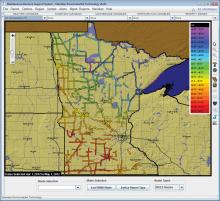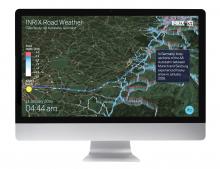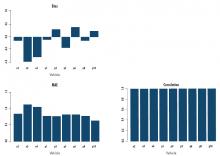Paul Pisano, USDOT Federal Highway Administration, and Charles Harris, Noblis Inc, chart progress in the US of Maintenance Decision Support Systems for winter maintenance and weather management

Paul Pisano, USDOT Federal Highway Administration, and Charles Harris, Noblis Inc, chart progress in the US of Maintenance Decision Support Systems for winter maintenance and weather management
Road maintenance personnel have long had the challenge of controlling snow and ice build-up on local, state and national roadways. In 1999, theMDSS was built upon extensive meteorological science, decision support and software development experience led by the
The open source deployment of MDSS has proved successful not only in the US but internationally as well, with at least four other commercial products derived from the standard NCAR/Federal version. Some 16 states have joined forces in a MDSS Pooled Fund Study led by the South Dakota DOT to have Meridian Inc. develop a customised MDSS capability.
Sponsored by the FHWA and the Intelligent Transportation System Joint Program Office (JPO), the most recent study to evaluate the cost-benefit ratio of MDSS took place in the city and county of Denver, Colorado during two winters, 2007-2008 and 2008-2009, covering 56 snow events. Although the study showed that for the majority of events the MDSS did not prove to show any benefits, for 10 cases the MDSS did in fact provide a significant benefit. The outcome of using refined information from MDSS was on average an almost $100,000 cost saving in labour per winter season. In addition, the MDSS qualitatively provided leaders with improved confidence in their decisions. Overall, Denver road managers found the MDSS to offer them valuable guidance in their efforts to fine-tune their maintenance decisions before and during snowstorms. MDSS has more than paid for itself and has become an integral part of the snow management process for the City and County of Denver.
Beyond the local perspective
MDSS incorporates tailored weather and pavement models which approximate small-scale weather effects on road systems that usually experience highly variable environmental conditions. The incorporation of numerous road and roadside environmental observations is critical to model accuracy. A complicating factor is the availability of road weather conditions across state, county and local jurisdiction boundaries, where one set of data from one transportation network of weather sensors may not be readily shared with another organisation simply due to system design. Another problem is recognising when weather observations may not be valid due to sensor damage or improper maintenance. One effective approach to these problems has been the Clarus system.Started in 2004 and growing every year, the Clarus system ingests road weather sensor data from many separate transportation networks across North America, quality checks the data and makes them readily available for applications such as MDSS. As of May 2010, Clarus ingests data from over 2,100 road environmental sensor stations in 37 states, 3 Canadian provinces, and four local DOT organisations.
Expanding the decision toolset
With the successful transition of the MDSS programme from government development to private development, FHWA launched a new area of development for road weather decision support tools using the expanded road weather data set from the Clarus System. This effort was organised around three different North American regions and specific applications or use cases.Two contract awards were made in October 2008 for the Clarus Regional Demonstration project which not only includes research and development of a decision tool as in the MDSS programme, but also implementation and evaluation in operational settings of various decision support tools. Decision support tool development is targeted to meet specific needs outlined in previously developed public transportation agency Concepts of Operations for new tailored weather products and services.
References
Glassco, Richard, et al, "Concept of Operations and Implementation Options for MDSS/MMS Data Exchange", Noblis Inc, September 2009
Pisano, Paul, et al, "The Clarus Regional Demonstration", Federal Highway Administration, February 2010
US Department Of Transportation (USDOT), Research & Innovation Technology Administration (RITA), "Seasons of Achievement - Accomplishments of the Road Weather Management Program", FHWA-JPO-10-004, October 2009
US Department Of Transportation (USDOT), Research & Innovation Technology Administration (RITA), "Benefit-Cost Assessment of a Maintenance Decision Support System (MDSS) Implementation: The City and County of Denver", FHWA-JPO-10-018, December 2009The Clarus Regional Demonstrations are divided into five use cases. The first use case provides a foundation for development of the other decision support tools by improving the science of road weather observing or forecasting. One approach is to use Clarus data as input to and validation for the occurrence and accumulation of freezing and frozen precipitation on roads as part of a pavement prediction system. Additional output from the pavement prediction system will be used as input for high-resolution surface-based weather forecast models.
The second use case addresses the problem of a road's ability to safely sustain various vehicle weights. A seasonal weight restriction decision support tool will help road managers to maintain roads while avoiding over-restricting commerce during freeze-thaw periods.
The third use case expands the scope of the current Federal MDSS tool beyond winter maintenance support to include advice year-round for construction management, roadway maintenance and other non-winter maintenance activities. The fourth use case focuses on cross-jurisdiction weather-related situations where inter-agency coordination based upon enhanced and systematic information sharing would benefit multiple stakeholders in large-scale severe weather events and evacuations. The fifth use case targets the people who are using the road system. Traveller information and advisories in various delivery formats have just begun across the US. The last use cases seek to improve current access and information quality for time-sensitive warnings about adverse road weather conditions and forecast information for enhanced travel planning for the public and private sectors. In all, at least four decision support systems or tools are expected from the Clarus Regional Demonstration Project.
Progress to date
One initial result from the first use case of the Clarus Regional Demonstration project has been a significant improvement in short-term road weather forecasts. Forecast improvement was shown for a variety of weather events, both historical and more recent cases, over two different regions in the US.Over the last year and a half, all four road weather decision support tools that use Clarus data have been developed using standard system engineering principles. All have been deployed to the operational partners at the State transportation level. The State DOT partners are still in the initial stages of using the decision tools. A significant amount of usability data has been gathered, but definitive evaluation results are still pending. The evaluation period runs into the fall of 2010.
Summary
The FHWA's Road Weather Management Program has successfully developed and transitioned the MDSS out of research status to operational status, with proven cost and safety benefits for winter road maintenance. With freely provided MDSS base software code, private sector companies have further developed and deployed enhanced MDSS tools to many other transportation organisations both in the US and abroad.As a complementary effort to the MDSS programme, the FHWA built and continues to operate and expand the Clarus System road weather observation database, which continuously collects data from road weather sensors across North America, then quality checks and offers easy access to the data. The Clarus System is the foundation for additional development of decision support tools which is under way and in the middle of its evaluation period at several state DOTs. Well beyond the winter maintenance challenge, new decision support tools are expected by the end of the year in the areas of summer maintenance, seasonal vehicle weight guidance, multi-state coordination and enhanced road weather travel advisories.
The FHWA envisions an end state where all environmental information is fully and automatically integrated into road operations and maintenance centres, so that hazardous weather impacts are quickly mitigated and associated costs minimised. The new decision support tools move beyond the current 'cope and avoid' state of management to the 'anticipate and exploit' stage in road operations. This end state would be characterised by a significant reduction in the current number of crashes, casualties and time lost on North America's roadways.










